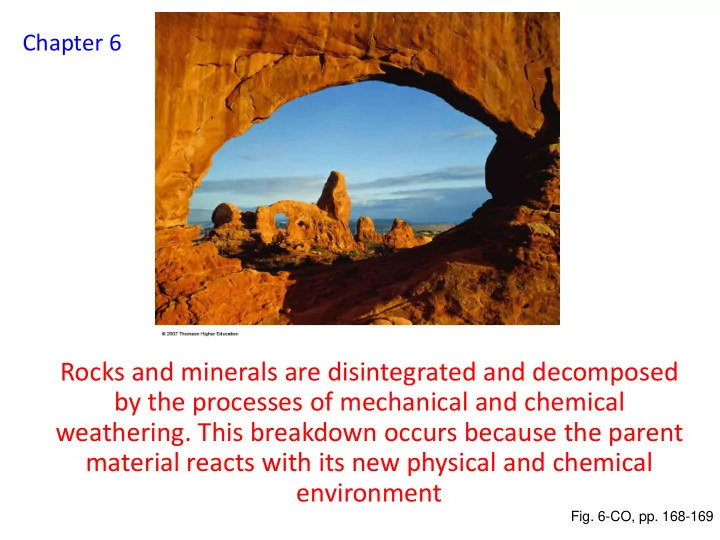

Chapter 6 Rocks and minerals are disintegrated and decomposed by the processes of mechanical and chemical weathering. This breakdown occurs because the parent material reacts with its new physical and chemical environment Fig. 6-CO, pp. 168-169
Introduction • How does weathering differ from erosion? • Weathering is the physical disintegration and chemical decomposition of rocks at or near Earth's surface – Erosion involves the removal and transportation of weathered materials from their place of origin-by running water or wind, for example. Fig. 6-3a, p. 172
Mechanical Weathering – Breaking Down of Earth Materials • Mechanical weathering includes the processes of – Frost action – Pressure release – Thermal expansion and contraction – Crystal growth (salts) – Activities of organisms. • The products of mechanical weathering are chemically the same as their parent materials. Fig. 6-3a, p. 172
Mechanical Weathering – • How do freezing and thawing contribute to weathering? – When water freezes in cracks in rocks it expands and then it contracts when it thaws, thus exerting pressure and opening the cracks wider. – Repeated freezing and thawing breaks rocks into angular pieces that may tumble downslope and accumulate as talus . Fig. 6-3a, p. 172
Talus
Frost Wedging As water freezes (changes from a liquid to a solid state). The expanding volume creates pressures which may break rocks and minerals into smaller pieces.
Mechanical Weathering – • What are sheet joints and how do they form? – Sheet joints are fractures that more or less parallel exposed rock surfaces, • especially rocks now at the surface that formed under great pressure at depth. – These joints form in response to pressure release; • when the rocks formed deep underground, they contained energy that is released by outward expansion when exposed at the surface. Fig. 6-4a, p. 173
Mechanical Weathering – • How do organisms contribute to mechanical and chemical weathering? – Any organic activity such as burrowing/particle mixing/root wedging/ reduction of particle size contribute to mechanical weathering – Organic acids aid in the chemical alteration of parent material. Fig. 6-6b, p. 174
Organisms and Mechanical Weathering
Thermal Expansion and Contraction
CRYSTAL GROWTH The expansion of water upon freezing, salts dissolved in water, its support of organic growth all facilitate the mechanical weathering processes. • precipitates that form as water in cracks evaporates. Such compounds are called SALTS . Ice crystals and other minerals that form in near-surface environments can also do the work.
Chemical Weathering – Decomposition of Earth Materials • Chemical weathering processes include – Solution – Oxidation – Hydrolysis • Hot and wet environments accelerate chemical weathering. • Chemical weathering occurs in all environments, except, possibly, permanently frozen polar regions. Fig. 6-10, p. 180
Chemical Weathering – • These processes cause a change in the chemical composition • Water is the dominant agent because it initiates chemical weathering. Rainfall (H 2 0) falls through our atmosphere that contains carbon dioxide (CO 2 ). The reaction of water and carbon dioxide results in an acid called carbonic acid (H 2 CO 3 ) Fig. 6-7, p. 175
Chemical Weathering – Decomposition of Earth Materials • Solution – – rocks dissolve • Carbonate Rocks – Rocks such as limestone (CaCO³) are nearly insoluble in neutral or alkaline solutions, but they rapidly dissolve in acidic solutions p. 194
Chemical Weathering – Decomposition of Earth Materials • Oxidation – – rocks rust – Rocks such as sandstone may contain iron minerals that will breakdown when exposed to the atmosphere – The atoms making up the minerals dissociate, that is, they separate as the rock rusts away. Concept Art, p. 177
Chemical Weathering – Decomposition of Earth Materials • Hydrolysis – – breakdown to clays • Potassium feldspar – During hydrolysis hydrogen ions react with and replace positive ions in potassium feldspar – The result is clay minerals and substances in solution such as potassium and silica. water is necessary for hydrolysis and the formation of carbonic acid. Water serves to hold and transport the dissolved products .
How does mechanical weathering contribute to the rate of chemical weathering? – Mechanical weathering enhances chemical weathering by breaking material into smaller pieces, thereby increasing the surface area for chemical reactions. – Because chemical weathering is a surface process, the more surface exposed, the faster the weathering. Fig. 6-12, p. 181
Mechanical and Chemical Weathering For both chemical and mechanical weathering, water also serves to transport/erode the weathering product. Concept Art, p. 176
Recommend
More recommend